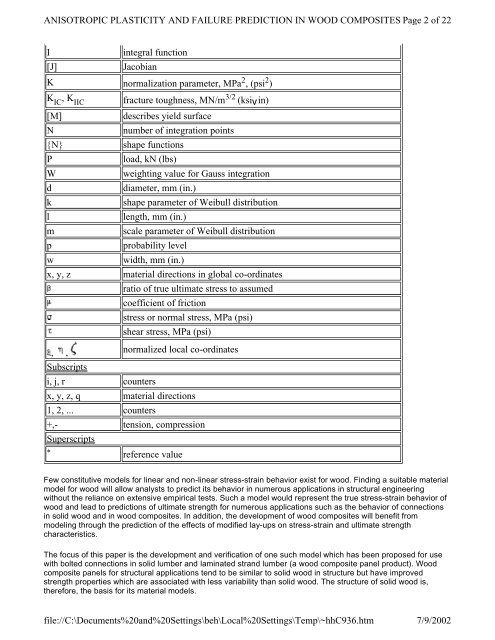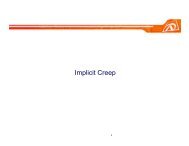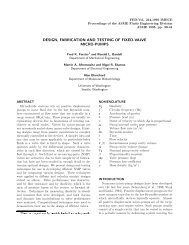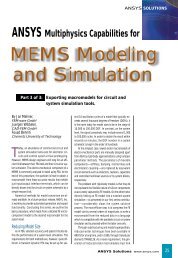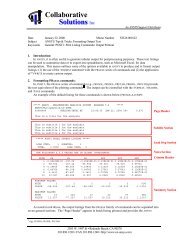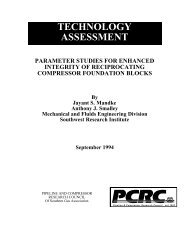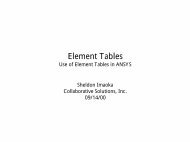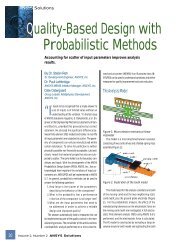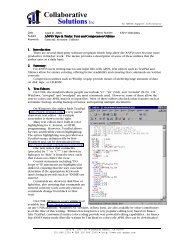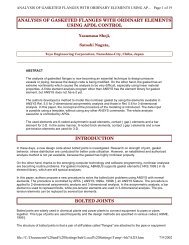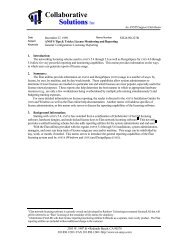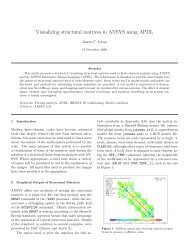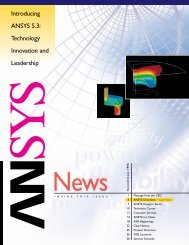anisotropic plasticity and failure prediction in wood ... - ANSYS Users
anisotropic plasticity and failure prediction in wood ... - ANSYS Users
anisotropic plasticity and failure prediction in wood ... - ANSYS Users
You also want an ePaper? Increase the reach of your titles
YUMPU automatically turns print PDFs into web optimized ePapers that Google loves.
ANISOTROPIC PLASTICITY AND FAILURE PREDICTION IN WOOD COMPOSITES Page 2 of 22<br />
I <strong>in</strong>tegral function<br />
[J] Jacobian<br />
K normalization parameter, MPa 2 , (psi 2 )<br />
K IC , K IIC<br />
fracture toughness, MN/m 3/2 (ksiv<strong>in</strong>)<br />
[M] describes yield surface<br />
N number of <strong>in</strong>tegration po<strong>in</strong>ts<br />
{N} shape functions<br />
P load, kN (lbs)<br />
W weight<strong>in</strong>g value for Gauss <strong>in</strong>tegration<br />
d diameter, mm (<strong>in</strong>.)<br />
k shape parameter of Weibull distribution<br />
l length, mm (<strong>in</strong>.)<br />
m scale parameter of Weibull distribution<br />
p probability level<br />
w width, mm (<strong>in</strong>.)<br />
x, y, z material directions <strong>in</strong> global co-ord<strong>in</strong>ates<br />
ratio of true ultimate stress to assumed<br />
coefficient of friction<br />
stress or normal stress, MPa (psi)<br />
shear stress, MPa (psi)<br />
, , normalized local co-ord<strong>in</strong>ates<br />
Subscripts<br />
i, j, r counters<br />
x, y, z, q material directions<br />
1, 2, ... counters<br />
+,- tension, compression<br />
Superscripts<br />
* reference value<br />
Few constitutive models for l<strong>in</strong>ear <strong>and</strong> non-l<strong>in</strong>ear stress-stra<strong>in</strong> behavior exist for <strong>wood</strong>. F<strong>in</strong>d<strong>in</strong>g a suitable material<br />
model for <strong>wood</strong> will allow analysts to predict its behavior <strong>in</strong> numerous applications <strong>in</strong> structural eng<strong>in</strong>eer<strong>in</strong>g<br />
without the reliance on extensive empirical tests. Such a model would represent the true stress-stra<strong>in</strong> behavior of<br />
<strong>wood</strong> <strong>and</strong> lead to <strong>prediction</strong>s of ultimate strength for numerous applications such as the behavior of connections<br />
<strong>in</strong> solid <strong>wood</strong> <strong>and</strong> <strong>in</strong> <strong>wood</strong> composites. In addition, the development of <strong>wood</strong> composites will benefit from<br />
model<strong>in</strong>g through the <strong>prediction</strong> of the effects of modified lay-ups on stress-stra<strong>in</strong> <strong>and</strong> ultimate strength<br />
characteristics.<br />
The focus of this paper is the development <strong>and</strong> verification of one such model which has been proposed for use<br />
with bolted connections <strong>in</strong> solid lumber <strong>and</strong> lam<strong>in</strong>ated str<strong>and</strong> lumber (a <strong>wood</strong> composite panel product). Wood<br />
composite panels for structural applications tend to be similar to solid <strong>wood</strong> <strong>in</strong> structure but have improved<br />
strength properties which are associated with less variability than solid <strong>wood</strong>. The structure of solid <strong>wood</strong> is,<br />
therefore, the basis for its material models.<br />
file://C:\Documents%20<strong>and</strong>%20Sett<strong>in</strong>gs\beh\Local%20Sett<strong>in</strong>gs\Temp\~hhC936.htm<br />
7/9/2002


